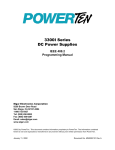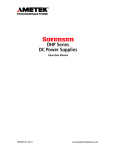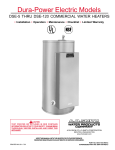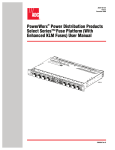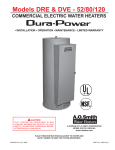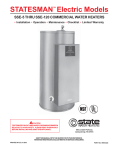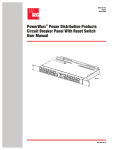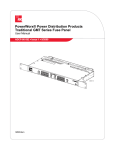Download Elgar 3300 Series Operating instructions
Transcript
3300 Series DC Power Supplies Operation Manual PowerTen 9250 Brown Deer Road San Diego, CA 92121-2294 1-800-978-6680 Tel: (858) 458-0253 Fax: (858) 458-0237 Email: [email protected] www.powerten.com ©2002 by PowerTen. This document contains information proprietary to PowerTen. The information contained herein is not to be duplicated or transferred in any manner without prior written permission from PowerTen. January 11, 2002 Document No. M520086-01 Rev A Safety Notice Before applying power to the system, verify that the unit is configured properly for the user's particular application. The 3300 series of power supplies is intended for rack mounted application only. Use of the power supplies outside of a rack mount enclosure will expose the user to high voltage and/or high current sources. Extreme caution must be used under these circumstances. The analog control inputs (connectors J1 and J2) on the rear panel are referenced to the negative output of the power supply. Grounding the positive output of the power supply or biasing the output of the supply above chassis potential will cause these inputs (along with the output of the supply) to have a potentially hazardous offset voltage. Exercise caution under these conditions. Under no circumstances should the output of the supply be biased more than 500 volts from chassis potential. Installation and service must be performed only by properly trained and qualified personnel who are aware of dealing with attendant hazards. This includes simple tasks such as fuse verification. Ensure that the AC power line ground is connected properly to the unit input connector or chassis. Similarly, other power ground lines including those to application maintenance equipment must be grounded properly for both personnel and equipment safety. Always ensure that facility AC input power is de-energized prior to connecting or disconnecting the input/output power cables. Warning: Lethal voltages may be present inside the power supply even when the AC input voltage is disconnected. Only properly trained and qualified personnel should remove covers and access the inside of the power supply. During normal operation, the operator does not have access to hazardous voltages within the chassis. However, depending on the user's application configuration, HIGH VOLTAGES HAZARDOUS TO HUMAN SAFETY may be generated normally on the output terminals. Ensure that the output power lines are labeled properly as to the safety hazards and that any inadvertent contact with hazardous voltages is eliminated. Due to filtering, the unit has high leakage current to the chassis. Therefore, it is essential to operate this unit with a safety ground. This unit is designed to be permanently connected to the power source and as such must have a readily accessible disconnect device incorporated in the fixed wiring. After the unit has been operating for some time, the metal near the rear of the unit may be hot enough to cause injury. Let the unit cool before handling. These operating instructions form an integral part of the equipment and must be available to the operating personnel at all times. All the safety instructions and advice notes are to be followed. Neither Power Ten nor any of the subsidiary sales organizations can accept responsibility for personal, material or consequential injury, loss or damage that results from improper use of the equipment and accessories. M520086-01 ii SERVICE SAFETY NOTICES WARNING! HAZARDOUS VOLTAGES IN EXCESS OF 480 V RMS, 700 V PEAK MAY BE PRESENT WHEN COVERS ARE REMOVED. QUALIFIED PERSONNEL MUST USE EXTREME CAUTION WHEN SERVICING THIS EQUIPMENT. CIRCUIT BOARDS, TEST POINTS, AND OUTPUT VOLTAGES MAY BE FLOATING ABOVE CHASSIS GROUND. WARNING! TO GUARD AGAINST RISK OF ELECTRICAL SHOCK DURING OPEN COVER CHECKS, DO NO TOUCH ANY PORTION OF THE ELECTRICAL CIRCUITS. EVEN WHEN THE POWER IS OFF, CAPACITORS CAN RETAIN AN ELECTRICAL CHARGE. USE SAFETY GLASSES DURING OPEN COVER CHECKS TO AVOID PERSONAL INJURY BY ANY SUDDEN FAILURE OF A COMPONENT. WARNING! SOME CIRCUITS ARE LIVE EVEN WITH THE FRONT PANEL SWITCH TURNED OFF. SERVICE, FUSE VERIFICATION, AND CONNECTION OF WIRING TO THE CHASSIS MUST BE ACCOMPLISHED AT LEAST FIVE MINUTES AFTER POWER HAS BEEN REMOVED VIA EXTERNAL MEANS; ALL CIRCUITS AND/OR TERMINALS TO BE TOUCHED MUST BE SAFETY GROUNDED TO THE CHASSIS. WARNING! QUALIFIED SERVICE PERSONNEL NEED TO BE AWARE THAT SOME HEAT SINKS ARE NOT AT GROUND, BUT AT HIGH POTENTIAL. M520086-01 iii FCC NOTICE This equipment has been tested and found to comply with the limits for a Class A digital device, pursuant to part 15 of the FCC Rules. These limits are designed to provide reasonable protection against harmful interference when the equipment is operated in a commercial environment. This equipment generates, uses, and can radiate radio frequency energy and, if not installed and used in accordance with the instruction manual, may cause harmful interference to radio communications. Operation of this equipment in a residential area is likely to cause harmful interference in which case the user will be required to correct the interference at his own expense. M520086-01 iv About This Manual This manual has been written expressly for the Power Ten 3300 Series of power supplies. SAFETY SYMBOLS CAUTION Risk of Electrical Shock Protective Conductor Terminal CAUTION Refer to Accompanying Documents Alternating Current (AC) M520086-01 v TABLE OF CONTENTS Chapter 1 DESCRIPTION OF EQUIPMENT____________________________________ 1-1 1.1 PURPOSE AND CAPABILITIES _______________________________________________ 1-1 1.2 TECHNICAL CHARACTERISTICS_____________________________________________ 1-1 Chapter 2 INSTALLATION __________________________________________________ 2-1 2.1 INSPECTION _______________________________________________________________ 2-1 2.2 INPUT/OUTPUT CONNECTORS ______________________________________________ 2-1 2.3 LOCATION AND MOUNTING ________________________________________________ 2-1 2.4 CHECKOUT AND PRELIMINARY ADJUSTMENTS ______ Error! Bookmark not defined. Chapter 3 OPERATING INSTRUCTIONS ______________________________________ 3-4 3.1 CONTROLS AND INDICATORS_______________________________________________ 3-4 3.1.1 3.1.2 3.1.3 3.1.4 3.1.5 3.1.6 3.1.7 3.1.8 3.1.9 Local Operation ________________________________________________________________ 3-4 Remote Current Programming _____________________________________________________ 3-7 Remote Voltage Programming _____________________________________________________ 3-7 Remote Sensing ________________________________________________________________ 3-8 Remote Output On/Off Control_____________________________________________________ 3-8 Auto-Parallel Operation __________________________________________________________ 3-9 Auto-Series Operation ___________________________________________________________ 3-9 Auto-Tracking Operation _________________________________________________________ 3-9 Output overvoltage Protection ____________________________________________________ 3-10 Chapter 4 MAINTENANCE AND CALIBRATION _______________________________ 4-1 4-1. INTRODUCTION ___________________________________________________________ 4-1 4-2. PREVENTIVE MAINTENANCE _______________________________________________ 4-1 4-3. CALIBRATION AND ADJUSTMENTS _________________________________________ 4-3 4.1.1 4.1.2 Converter Assembly Calibration____________________________________________________ 4-3 Display Assembly _______________________________________________________________ 4-6 M520086-01 vi LIST OF TABLES TABLE 1-1 3300 SERIES TECHNICAL CHARACTERISTICS ...................................................... 1-2 TABLE 1-2 3300 SERIES TECHNICAL CHARACTERISTICS ...................................................... 1-4 TABLE 2-1 3300 SERIES INPUT/OUTPUT CONNECTORS ........................................................ 2-2 TABLE 3-1 3300 SERIES CONTROLS AND INDICATORS.......................................................... 3-5 TABLE 3-2 BARRIER STRIP (TB1) DESIGNATIONS AND FUNCTIONS .................................... 3-6 TABLE 4-1 PREVENTIVE MAINTENANCE SCHEDULE .............................................................. 4-1 TABLE 4-2 INSPECTION AND CORRECTIVE ACTION............................................................... 4-2 LIST OF FIGURES FIGURE 3-1 3300 SERIES CONTROLS AND INDICATORS ....................................................... 3-4 FIGURE 3-2 NORMAL CONNECTION PATTERN...................................................................... 3-11 FIGURE 3-3 REMOTE RESISTANCE PROGRAMMING OF OUTPUT CURRENT ................... 3-11 FIGURE 3-4 REMOTE VOLTAGE PROGRAMMING OF OUTPUT CURRENT ......................... 3-12 FIGURE 3-5 REMOTE RESISTANCE PROGRAMMING OF OUTPUT VOLTAGE.................... 3-12 FIGURE 3-6 REMOTE VOLTAGE PROGRAMMING OF OUTPUT VOLTAGE.......................... 3-13 FIGURE 3-7 REMOTE SENSING OPERATION.......................................................................... 3-13 FIGURE 3-8 REMOTE ON/OFF CONTROL BY CONTACT CLOSURE ..................................... 3-14 FIGURE 3-9 REMOTE ON/OFF OPERATION USING AC/DC VOLTAGE SOURCE ................. 3-14 FIGURE 3-10 AUTO-PARALLEL OPERATION........................................................................... 3-15 FIGURE 3-11 AUTO-SERIES OPERATION................................................................................ 3-16 FIGURE 3-12 AUTO-TRACKING OPERATION .......................................................................... 3-17 M520086-01 vii Chapter 1 DESCRIPTION OF EQUIPMENT 1.1 PURPOSE AND CAPABILITIES The Power Ten 3300 Series power supplies are general purpose power supplies designed specifically for laboratory test and systems applications requiring variable DC sources with good regulation and low output ripple characteristics. Models of the 3300 Series are constant current/constant voltage supplies with an automatic crossover feature. They provide up to 1000 watts of DC power over a wide range of voltage and current levels. 1.2 TECHNICAL CHARACTERISTICS The physical, electrical and environmental characteristics for the 3300 Series are listed in Tables 1-1 and 1-2. M520086-01 1-1 Table 1-1 3300 Series Technical Characteristics PARAMETERS SPECIFICATIONS PHYSICAL CHARACTERISTICS: Width Depth Height Weight 19.00 in. 18.50 in 1.75 in. 15 lb. max. ELECTRICAL CHARACTERISTICS: Input Power (Standard) Voltage Frequency Phases 95 to 127 VAC, 190 to 253 VAC (Option) 47 to 63 Hz Single, 2-wire plus gnd Regulation (Line or Load) Voltage Current 0.1% of max. output voltage 0.1% of max. output current Noise and Ripple (RMS) 30 mV max. Transient Response A 30% step load will recover to within 2% of original value within 10 ms. Stability +0.05% of set point per 8 hr. after warm-up and at a fixed line, load and temperature. Remote Control/Monitor On/Off control via contact closure, 6-120 VDC or 12-240 VAC. Power Density 2.5 Watts/cubic in. Power Factor .99 min. at full load Total Harmonic 2.5% max. M520086-01 1-2 Table 1-1 3300 Series Technical Characteristics - Continued PARAMETERS SPECIFICATIONS Remote Programming Resistive: Constant Voltage (0-100%) Constant Current (0-100%) 0 - 5k ohms 0 - 5k ohms Voltage: Constant Voltage (0-100%) Constant Current (0-100%) 0 - 5 VDC 0 - 100 mV Current: Constant Voltage (0-100%) Constant Current (0-100%) 0 - 1 mA 0 - 1 mA Remote Sensing Terminals are provided to sense output voltage at point of load. Maximum line drop 3% of rated voltage per line. ENVIRONMENTAL CHARACTERISTICS: Temperature Coefficient 0.02%/°C of max. output voltage rating for voltage set point. 0.03%/°C of max. output current rating for current set point. Ambient Temperature Operating Storage 0 to 50°C -40° to 75°C Cooling Internal blowers M520086-01 1-3 Table 1-2 3300 Series Technical Characteristics MODEL NUMBER OUTPUT DC VOLTS OUTPUT DC AMPS OUTPUT RIPPLE (RMS) 7.575 0-7.5 75 30 mV 7.5125 0-7.5 125 30 mV 1060 0-10 60 30 mV 10100 0-10 100 30 mV 2030 0-20 30 30 mV 2050 0-30 50 30 mV 3020 0-30 20 30 mV 3033 0-30 33 30 mV 4015 0-40 15 30 mV 4025 0-40 25 30 mV 5020 0-50 20 30 mV 6010 0-60 10 30 mV 6016 0-60 16 30 mV 8006 0-80 6 50 mV 8012 0-80 12 50 mV 10010 0-100 10 50 mV 1208 0-120 8 50 mV 1507 0-150 7 50 mV M520086-01 1-4 Chapter 2 INSTALLATION 2.1 INSPECTION Inspect the shipping carton for possible damage before unpacking the unit. Carefully unpack the equipment. Save all packing materials until inspection is complete. Verify that all items listed on the packing slips have been received. Visually inspect all exterior surfaces for broken knobs, connectors or meters. Inspect for dented or damaged exterior surfaces. External damage may be an indication of internal damage. If any damage is evident, immediately contact the carrier that delivered the unit and submit a damage report. Failure to do so could invalidate future claims. 2.2 INPUT/OUTPUT CONNECTORS Table 2-1 lists all external connections for the 3300 Series models. For permanently connected equipment, a readily accessible disconnect device shall be incorporated in the fixed wiring. For pluggable equipment, the socket outlet shall be installed near the equipment and shall be easily accessible. 2.3 LOCATION AND MOUNTING The 3300 Series models are intended for mounting in a standard 19.0-inch equipment rack. Four captive screws, two on each side of the front panel, are used to secure the unit in place. Optional slide mounting is available. NOTICE The unit should be provided with proper ventilation. The top, rear and both sides of the unit should be free of obstructions. Follow the instructions in paragraph 3.1.1 for setup and operation of the equipment. M520086-01 2-1 Table 2-1 Output Connection Descriptions SUPPLY TYPE CONNECTION DESCRIPTION Output <=60V Bus Bar with hole for 1/4” bolt Output >=80V Terminal Block with 6-32 screws Table 2-2 Input Connection Descriptions SUPPLY TYPE CONNECTION DESCRIPTION 3300, 3300I Terminal Block with 6-32 screws Table 2-3 3300 Series Input/Output Connectors CONNECTOR FUNCTION CONNECTS TO TB2 - AC TB2 - AC CHASSIS - GND Prime Power Input (Std)* Prime Power Input (Std)* 95 to 127 VAC 47 to 63 Hz Power Source Pos. Bus Bar Neg. Bus Bar GND Stud Output Power Output Power User load(s) User Load(s) TB1 Control Interface See Table 3-2 for a description *190 to 253 VAC is available as a factory option M520086-01 2-2 2.4 WIRE SIZING Care must be taken to properly size all conductors for the input and output of the power supply. Table 2-5 below gives minimum recommended wire size for the input. This table is derived from the National Electrical Code and is for reference only. Local laws and conditions may have different requirements. The table is for copper wire only. Table 2-4 Minimum Wire SizeTable SIZE AWG MCM 14 12 10 8 6 4 3 2 1 0 2.5 TEMPERATURE RATING OF COPPER CONDUCTOR 60 °C 75 °C 85 °C 90 °C TYPES TYPES TYPES TYPES RUW, T, TW, FEPW, RH, V, MI TA, TBS, SA, UF RHW, RUH, AVB, SIS, FEP, THW, THWN, FEPB, RHH, XHHW, USE, THHN, XHHW ZW CURRENT RATING 20 20 25 25 25 25 30 30 30 35 40 40 40 50 55 55 55 65 70 75 70 85 95 95 85 100 110 110 95 115 125 130 110 130 145 150 125 150 165 170 OUTLINE DRAWINGS The following page (figure 2-1) shows the outlines and overall dimensions for 3300 product line. M520086-01 2-2 NEG TB1 POS TB2 16.75 Ø0.25 2 PL 1.00 18.15 0.125 1.75 19.00 Figure 2-1 Outline Drawing, 3300 Series M520086-01 2-3 Chapter 3 OPERATING INSTRUCTIONS 3.1 CONTROLS AND INDICATORS Front panel controls and indicators for the 3300 Series are identified in Figure 3-1 with index numbers keyed to Table 3-1. Table 3-1 provides a description of all operator controls and indicators. 3.1.1 Local Operation Units are shipped from the factory configured for local voltage/current control and local voltage sensing. This configuration is used for applications where the IR drop of the load wires is insufficient to degrade performance at the load. Prior to turning the unit on, rotate the voltage and current potentiometers fully counterclockwise (minimum output). Then switch the power to the ON position and adjust the voltage and current to the desired output. Figure 3-1 3300 Series Controls and Indicators M520086-01 3-4 Table 3-1 3300 Series Controls and Indicators FIGURE & INDEX NO. CONTROL/INDICATOR FUNCTION 3-1 1 Circuit Breaker Provides fault protection 2 Power Switch Applies AC power to the power supply. 3 VOLTAGE Meter Measures voltage output. 4 Voltage Mode Indicator Indicates the power supply is operating in the voltage mode. 5 Current Mode Indicator Indicates the power supply is operating in the current mode 6 CURRENT Meter Measures current output. 7 Overvoltage (OV) Indicator Indicates output voltage has exceeded preset level, and power supply output is turned off. 8 Fault Indicator Adjusts overvoltage trip level. 9 Local Output Current Control Adjusts current output to a desired level. 10 Local Output Voltage Control Adjusts voltage output to a desired level. M520086-01 3-5 Table 3-2 Barrier Strip (TB1) Designations and Functions TB1 DESIGNATOR SCHEMATIC SYMBOL FUNCTIONAL DESCRIPTION 1 V+ Positive output voltage for local voltage sensing. 2 VS+ Positive voltage sensing terminal.* 3 VPROG 1 milliamp current source for either local or remote voltage programming using resistance. 4 VCONT Voltage control input terminal. 5 VSET 6 VS- Front panel voltage control potentiometers for local control. . Negative voltage sensing terminal.* 7 V- Negative output voltage for local voltage sensing. 8 IPROG 1 milliamp current source for either local or remote current programming using resistance. 9 ICONT Current control input terminal. 10 ISET Front panel current control potentiometers for local control. 11 IMON Negative current monitor terminal. Return for remote current programming resistor. 12 IMON+ 0-5 VDC = 0-100% rated current. Use positive current monitor terminal or 0-1 milliamp auto-tracking control output terminal. Referenced to TB1-13. 13 ON/OFF CONTACT RTN Control Circuit Common. Used with TB1-12 for current monitor and/or TB1-14 for remote on/off control return. 14 ON/OFF CNTCT CTRL Remote on/off control using contacts of switch or relay. *Except in models in excess of 60 VDC output. M520086-01 3-6 Table 3-2 Barrier Strip (TB1) Designations and functions - Continued TB1 DESIGNATOR SCHEMATIC SYMBOL FUNCTIONAL DESCRIPTION 15 ON/OFF AC/DC RTN Return for AC/DC voltage source used for remote on/off control. 16 ON/OFF AC/DC Externally supplied AC/DC voltage source for on/off output voltage control. This is a positive (+) terminal for DC voltage. 3.1.2 Remote Current Programming The remote current programming is used for applications that require the output current be programmed (controlled) from a remote source. An external resistance or external voltage source may be used as a programming device. When using remote current programming, a shielded, twisted-pair, hookup wire is recommended to prevent noise interference with programming signals. a. External Current Programming Using Resistance. The resistance coefficient for remote current programming is 100 ohms = 100% rated output. The programming current from the current control programming terminal A3 is factory set for 1 milliamp. If multiple switches or relays are used to program different levels, make-before-break contacts are recommended. See Figure 33 for connection requirements. b. External Current Programming Using a Voltage Source. The voltage coefficient for remote current programming is 1 millivolt per percent of rated output current or 100 millivolts = 100% of rated output. On models with 10 V programming, the programming coefficient is 0.1 volt per percent of rated output or 10 volts = 100%. See Figure 3-4 for connection requirements. 3.1.3 Remote Voltage Programming The remote voltage programming configuration is used for applications that require the output voltage be programmed (controlled) from a remote source. An external resistance or external floating voltage source may be used as a programming device. When using remote voltage programming, a shielded, twisted-pair, hookup wire is recommended to prevent noise interference with programming signals. a. External Voltage Programming Using Resistance. The resistance coefficient for remote voltage programming is 5k ohms = 100% of rated output voltage. The programming current from terminal 3 is factory set to 1 mA. If multiple switches or relays are used to program different levels, make-before-break contacts are recommended. See Figure 3-5 for connection requirements. b. External Voltage Programming The voltage coefficient for external voltage programming is 5 volts = 100% of rated output voltage. On models with 10 V M520086-01 3-7 programming, the programming coefficient is 0.1 volt per percent of rated output or 10 volts = 100%. See Figure 3-6 for connection requirements. 3.1.4 Remote Sensing In applications where the load is located some distance from the power supply, or the voltage drop of the power output leads significantly interferes with load regulation, remote voltage sensing may be used. When remote sensing is used, voltage is regulated at the load versus the power supply output terminals. To connect the power supply for remote voltage sensing (see Figure 3-7 for connection requirements), perform the following procedure. CAUTION If the power supply is operated with load power lines disconnected and sensing line connected, internal power supply damage may occur. (Output current then flows through sensing terminals.) a. Remove jumper between the positive sense terminal (TB1-2) and the positive output monitor terminal (TB1-1). b. Remove jumper between the negative sense terminal (TB1-6) and the negative output monitor terminal (TB1-7). c. Connect sensing leads from the load positive to TB1-2 and the load negative to TB1-6. A shielded, twisted pair is recommended to avoid potential noise interference. 3.1.5 Remote Output On/Off Control Remote on/off control may be accomplished by contact closure or by an isolated external AC/DC voltage source. a. Remote on/off by contact closure. Output is on when contacts are closed. See Figure 3-8 for connection requirements. b. Remote on/off control may be accomplished by an external 12 to 240 VAC or 6 to 120 VDC source. Application of AC/DC voltage will turn on the power supply. See Figure 3-9 for connection requirements. M520086-01 3-8 NOTE The following modes of operation are used for applications requiring more current or voltage than is available from a single power supply. To meet the requirements for greater output voltage or current, two or more supplies may be connected in series or parallel. 3.1.6 Auto-Parallel Operation In the auto-parallel mode of operation, a master/slave configuration is established. CAUTION When using two or more supplies in parallel, damage may occur to slave(s) crowbar circuits if slave overvoltage level is set lower than the level set on the master. To prevent damage, set all slave units overvoltage-set potentiometers fully clockwise; and set the master unit to the desired trip level. If overvoltage protection is not desired, set to trip at maximum rated voltage (less than fully clockwise). To set up the auto-parallel mode of operation, connect all outputs in parallel to the load. Connect jumper from master TB1-12 to slave TB1-9 and TB1-10. Remove jumper between slave TB1-8 and TB1-9. Rotate slave voltage control potentiometers to maximum, and adjust current control potentiometers for balanced output currents during operation. Once adjusted, output currents will track automatically. If tracking is not close, perform the calibration procedures listed in Chapter 4. See Figure 3-10 for connection requirements. 3.1.7 Auto-Series Operation In the auto-series mode of operation, a master/slave configuration is established. With two more supplies connected in series, one is established as master and the remaining supply as the slave. The master supply must always be the most positive unit. When operating in the auto-series mode, voltage control potentiometer settings determine the percentage of total load voltage contribution by the slave unit. Current control potentiometer of the slave unit is active and should be set to maximum clockwise position. See Figure 3-11 for connection requirements. 3.1.8 Auto-Tracking Operation In the auto-tracking mode of operation, a master/slave configuration is established. In this configuration, two or more supplies may be connected with common negative outputs. The slave(s) output voltage is a percentage of the master as controlled by the value of Rx. M520086-01 3-9 Individual current controls on both master and slave(s) remain active. See Figure 3-12 for connection requirements. 3.1.9 Output overvoltage Protection If the power supply is equipped with an overvoltage crowbar, the front panel will contain overvoltage adjustment. The potentiometer controlling overvoltage may be adjusted through an access hole in the front panel. NOTE All overvoltage circuitry has been properly adjusted to their respective unit before leaving the factory. For trip levels less than the maximum output voltage or to check the overvoltage circuitry, perform the following procedure. a. Set the potentiometer fully clockwise. b. Adjust the power supply output voltage to the desired trip level. c. Slowly adjust the potentiometer counterclockwise until overvoltage is tripped. M520086-01 3-10 Figure 3-2 Normal Connection pattern Figure 3-3 Remote Resistance Programming of Output Current M520086-01 3-11 Figure 3-4 Remote Voltage Programming of Output Current Figure 3-5 Remote Resistance Programming of Output Voltage M520086-01 3-12 Figure 3-6 Remote Voltage Programming of Output Voltage Figure 3-7 Remote Sensing Operation M520086-01 3-13 Figure 3-8 Remote On/Off Control by Contact Closure Figure 3-9 Remote On/Off Operation Using AC/DC Voltage Source M520086-01 3-14 Figure 3-10 Auto-Parallel Operation M520086-01 3-15 Figure 3-11 Auto-Series Operation M520086-01 3-16 Figure 3-12 Auto-Tracking Operation M520086-01 3-17 Chapter 4 MAINTENANCE AND CALIBRATION 4.1 INTRODUCTION This chapter contains preventive maintenance information and calibration procedures for the 3300 Series. WARNING All maintenance that requires removal of the cover of the unit should only be done by properly trained and qualified personnel. Hazardous voltages exist inside the unit. 4.2 PREVENTIVE MAINTENANCE Preventive maintenance for the 3300 Series consists of scheduled inspection and cleaning. a. Schedule. Table 4-1 lists the preventive maintenance routines and the recommended performance intervals. b. Inspection. Table 4-2 lists the visual inspection checks to be performed. It also indicates the corrective action to be taken. c. Cleaning. Cleaning requirements are based on the need established during inspection. If cleaning is required, follow the instruction listed in the corrective action column of Table 4-2. Table 4-1 Preventive Maintenance Schedule PREVENTIVE MAINTENANCE ROUTINE RECOMMENDED PERFORMANCE INTERVAL Inspection Annual Cleaning As Required M520086-01 4-1 Table 4-2 Inspection and Corrective Action ITEM External Connector plugs and jacks INSPECT FOR Looseness, bent or corroded contacts, damage or improper seating in mating connector CORRECTIVE ACTION Clean contacts with solvent moistened cloth, soft bristle brush, small vacuum or low compressed air. Replace connectors damaged, deeply corroded, or improperly seated in mating connector. Chassis, blower & extruded heatsinks Dirt and Corrosion Clean with cloth moistened with soapy water. External Electrical Wiring Broken, burned or pinched wire; frayed, worn or missing insulation Repair or replace defective wires. External Solder Connections Corrosion, loose, cracked, or dirty connections Clean and resolder connections. Dirt and moisture buildup Short circuits, arcing, corrosion, overheating Clean as required. Front panel controls and meters Dirt and corrosion Clean with cloth moistened with soapy water. Use a Kimwipe tissue and glass cleaning compound to clean the meter faces. M520086-01 4-2 4.3 CALIBRATION AND ADJUSTMENTS To perform the following calibration and adjustment procedures, the cover must be removed from the power supply. Because removal of the cover allows access to potentially hazardous power voltages (up to 253 VAC or 358 VDC) and because of the importance of accurate readings to performance, only technically trained personnel should perform calibration procedures. WARNING Hazardous voltages (up to 253 VAC or 358 VDC) during equipment operations. Press power switch to OFF position and disconnect power cable from power source. Allow a minimum of 5 minutes for discharge of storage capacitance before removing the cover or performing any maintenance function. Wear safety glass with cover removed. The calibration Test Setup procedures require the following: remove prime power; connect the power supply to a resistive load capable of full-rated voltage and current. Connect a precision current shunt in series with either the positive or negative output between the power supply and the resistive load. Two digital multimeters are required to perform the calibration procedures. 4.3.1 Converter Assembly Calibration Voltage Reference The voltage reference is provided by an adjustable current regulator Q15. To calibrate for the 1 mA programming coefficient (constant voltage), the following sequence is recommended. a. Remove all jumpers and external connections to TB1-3. b. Set current control potentiometer on front panel fully counterclockwise. c. Connect a precision digital multimeter (DMM) to TB1-3(+) with reference to TB1-7(-). Set DMM to DC milliamps and 2 milliamp range. d. Apply power to the power supply. e. Adjust R69 for 1.000 milliamps on DMM. Current Reference The current reference is a precision current source consisting of Q16 and associated resistors. Calibration is accomplished by adjusting R71. The following sequence is recommended. a. M520086-01 Remove all jumpers and external connections to TB1-8. 4-3 b. Set voltage control potentiometer on front panel fully counterclockwise. c. Connect a precision DMM to TB1-8(+) with reference to TB1-11(-). Set DMM to DC milliamps and 2 milliamp range. d. Apply power to power supply. e. Adjust R71 for 1.000 milliamps on DMM. Current Zero Calibration The voltage control circuit (U8) zero is adjusted by R106. The following sequence is recommended. a. Connect jumper (short circuit) between TB1-4 and TB1-6. b. Connect resistive load and DMM across output terminals of power supply. Set DMM to read DC volts and approximately 200 millivolt range. c. Set current control potentiometer full clockwise. d. Apply power to power supply. e. Adjust R106 until the power supply output voltage starts to increase in the normal polarity. Reverse adjustment direction of R106 until output voltage decreases to zero reading on the DMM. Do not continue adjustment once the output reads zero millivolts. Voltage Full-Scale Calibration Full-scale voltage calibration is accomplished by adjusting R101. The following sequence is recommended. a. Connect a resistive load across output terminals. b. Connect a DMM between TB1-2 and TB1-6. Set DMM to DC volts and the scale to read maximum rated power supply voltage. c. Connect a second DMM between TB1-4(+) and TB1-6(-). Set DMM to DC volts and scale to read 5.00 volts. d. Rotate current control to maximum clockwise. e. Apply power to power supply. f. Rotate voltage control for 5.00 volt reading to DMM attached to TB1-4 and TB1-6. g. Adjust R101 until output voltage reading is 100% of rated output voltage DC between TB1-2 and TB1-6. Current Zero Calibration The current control circuit (U7) zero is adjusted by R87. The following sequence is recommended. a. Connect a jumper (short circuit) between TB1-9 and TB1-11. b. Connect a resistive load and DMM across the output terminals of the power supply. Set DMM to read DC volts and approximately 200 millivolt range. c. Set voltage control potentiometer on front panel fully clockwise. d. Apply power to power supply. M520086-01 4-4 e. Adjust R87 until the power supply output voltage starts to increase in normal polarity. Reverse adjustment direction of R87 until output voltage decreases to zero reading on the DMM. Do not continue adjustment when the output reads zero volts. Current Full-Scale Calibration Full-scale current calibration is accomplished by adjusting R88. The following sequence is recommended. a. Connect an external calibrated current shunt between the power supply negative output and a resistive load bank capable of full-rated power. (Optionally, the shunt may be connected between the power supply positive and negative output bus bars.) b. Connect DMM across current shunt sensing terminals. c. Connect a DMM between TB1-9(+) and TB1-11(-). Set to 200 millivolt range. d. Set front panel voltage control potentiometer fully clockwise. e. Apply power to power supply. f. Adjust front panel current control for 100 millivolt reading on DMM across TB19 and TB1-11. g. Adjust R88 until rated output current flows through external current shunt. Current Monitor/Parallel Tracking Amplifier Zero Calibration The Current monitor/parallel tracking amplifier zero is accomplished by adjusting R79. The following sequence is recommended. a. Connect a jumper (short circuit) between TB1-9 and TB1-11. b. Connect a resistive load across output terminals. c. Connect a DMM between TB1-12(+) and TB1-13(-). Set DMM to DC volts on 0.2 volt scale. d. Set front panel voltage and current control potentiometers fully counterclockwise. e. Apply power to power supply f. Adjust R79 to 0.00 volts on DMM. g. Remove power from power supply. h. Remove jumper between TB1-9 and TB1-11. i. Remove resistive load from power supply output terminals. j. Reconfigure power supply for normal operation. M520086-01 4-5 Current Monitor/Parallel Tracking Amplifier Full-Scale Calibration The current monitor/parallel tracking amplifier is accomplished by adjusting R77. The following sequence is recommended. a. Connect an external calibrated current shunt between the power supply negative output and a resistive load bank capable of full-rated power. (As an option, the shunt may be connected between the power supply positive and negative output bus bars.) b. Connect a DMM across the current shunt sensing. c. Connect a DMM between TB1-12 and TB1-13. d. Set front panel voltage control potentiometers fully clockwise. e. Apply power to power supply. f. Set front panel current control potentiometers for rated output current through external current shunt. g. Adjust R77 for 5.00 volts DC reading on DMM connected between TB1-12 and TB1-13. h. Remove power from power supply. i. 4.3.2 Reconfigure power supply for normal operation. Display Assembly Meter Zero Calibration The zero set for both voltage and current front panel meter is automatic. Meter Full-Scale Calibration The full-scale adjustment for the digital panel meters M1 and M2 is adjusted by R8 and R11, respectively, of the display assembly 10-010-086-00. R8 is for full-scale current meter calibration, and R11 is for full-scale voltage meter calibration. Both resistors are accessible from inside the power supply when the cover is removed. To calibrate for full-scale voltage or current, adjust the power supply to maximum rated output voltage (or current) using external calibrated meters and adjust the appropriate meter to correspond to the rated output voltage or current. M520086-01 4-6



































